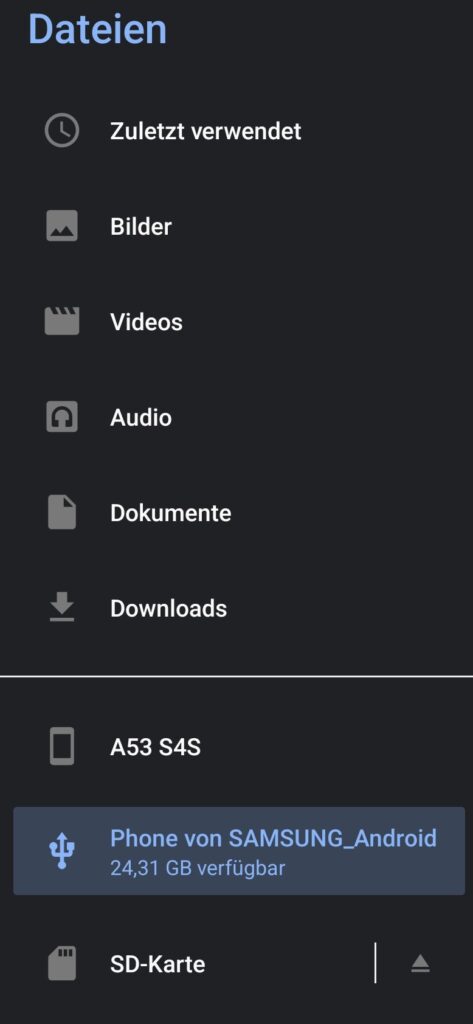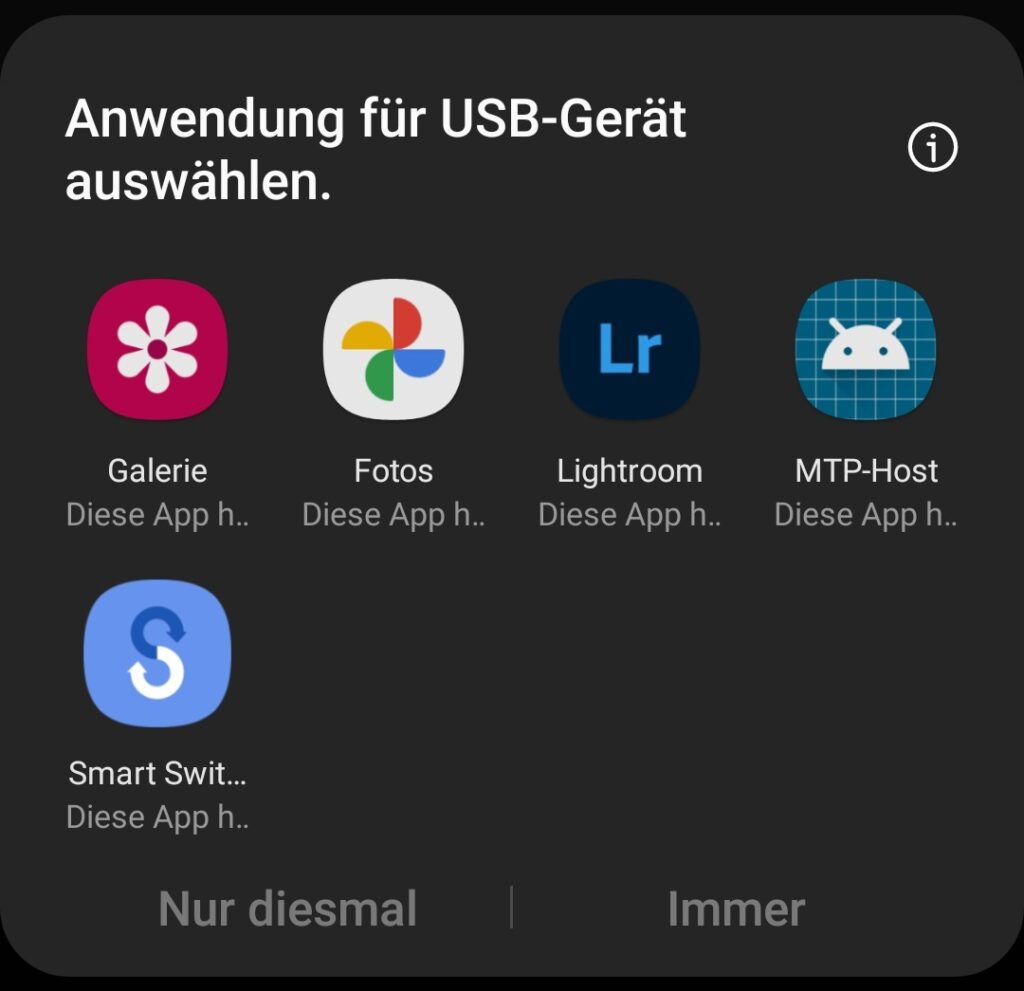While searching for a USB adapter in my USB adapter box, I found the USB-C to USB-A OTG adapter again and in the next box was my floppy drive. A grab in the other devices box quickly gave me the idea for some quick experiments and fun photo ideas.
Prehistory
Connecting something to Windows PCs via USB which was invented for Windows PCs (even if for WinXP) is not that thrilling, but nowadays there are plenty of alternatives. I know that my Samsung Galaxy A53 is more limited with USB than my earlier Galaxy Note models (especially without MHL) and doesn’t perform as well on the docking station. The keyboard and mouse work smoothly, but do not make much sense on the small screen when you can also use the most important apps directly on the PC.
The only device I have used more extensively as a mobile PC and for presentations is my HTC X7500 Athena.

It is also my first smartphone with a USB port. The VPA III before that still had a proprietary charging port. Due to the lack of an OTG adapter from Mini-USB-B to USB-A, I do not know whether USB devices are supported. However, I almost suspect not.
The VGA adapter (not USB, but a kind of mini VGA port) of the X7500 let the device connect to a projector and giving presentations with it was pretty cool – even if with modest resolution. In general, it was the device I was very often asked about, because it looked very strange in public. Only making calls was awkward (besides the weight of 400g with the case), because there was only the option of hands-free (but seems to be the same in many phones today, if you look around in the suburban train) or just a Bluetooth headset. I didn’t think about USB headsets back then.
On subsequent smartphones, especially the Samsung Galaxy Note series, I used OTG from Micro-USB-B at least regularly to connect and control my Canon 600D DSLR via cable. Since switching to newer cameras, I only use WLAN, of course.
Beyond that, I have never used USB seriously (neither mouse nor keyboard).
With my Samsung Galaxy Note devices (1, 3, 7, 4 – in that order) it was always an option at least as a gimmick, even if I didn’t yet have a USB/Thunderbolt docking station to make it easier. At least keyboard and mouse I tested once and connecting screens via MHL is more convenient than the wireless options.
Tests
Now for the fun stuff. I simply used my smartphone and tablet for the tests and connected various devices.
Since I do not own an OTG adapter for Lightning, I was able to test comparable functionalities on the iPhone. Since corresponding adapters are sold, I assume that it also works. If my Thunderbolt dock would work on the iPhone, I would even have a use for it.
Floppy Disk
With the good old USB floppy disk drive with MS-DOS 3.0 on the floppy disk, I was actually very skeptical whether Android 12 or Chrome OS would be able to handle the file system or whether it would work at all (demagnetization, moving parts, etc.). But that was no problem at all in both cases. You just need some patience, since the floppy drive doesn’t react like a flash memory. Well, to start MS-DOS was not my objective at all and is probably more complex on ARM than I have time for. It wouldn’t help me to find my Windows 3.1 or Windows 95 floppy disk sets again. Doom as a reference test also runs easier also both devices 🙃.
Well, if you have already connected the floppy drive, you can think about the purpose. With the picture of Windows 3.1 (only to the illustration) also wanted to create a meme myself:

Speaking of Windows ME. This always reminds me of my favorite XKCD comic: https://xkcd.com/323/.

My empirical tests on this theory during my diploma thesis are also no secret.
Back to the topic: Well, what is the use of my floppy disk drive now? Since my tablet doesn’t support micro SD cards, I now have the option of 1.44 MB of flexible storage on the go. With the speed and low amount of floppy discs available, I guess I’ll have to think about it further.
Optical drive
I was actually most confident about the CD/DVD/BluRay drive, but neither of the devices made any effort to recognize it. I think the driver for the USB-SATA adapter might be the problem. Since it doesn’t work in general, it doesn’t make any distinction what kind of optical disc was inserted.
I would be really happy if I could use my smartphone as a replacement for my broken Discman.
That would be my “Super Portable Optical Technology for Intense FidelitY” (what do you think of the acronym SPOTIFY?). Alright, maybe something similar will be invented one day to listen to music on the go.

Watching DVDs on the tablet would actually have been an option for me (definitely someday maybe – but not with so many cables):

Hard disk/SSD
Works directly and was also no surprise. Only that Android 12 and Chrome OS handle NTFS without problems surprised me a bit. In earlier tests, I seem to remember that only FAT ran without problems. However, my external HDDs and SSDs use Windows storage pools and these are of course not recognized.
It doesn’t need a photo because it looks very similar to a floppy disk drive or even a power bank.
WLAN stick
My server (former gaming PC) used to need a WLAN adapter and I tried this one on both devices as well. Android does nothing at all and Chrome OS at least offers me to mount the device in Linux. However, that is not my intention (and honestly not my core competence) and I let it be. At least it looks fancy and would certainly raise a lot of questions in public.
The WLAN stick doesn’t do anything on the power bank, but it looks like something.

Smartphone
Android
Connecting two Android phones was already specified when setting up the new device for data transfer. In this case, however, the OTG adapter was not necessary at all, since both devices were connected via a pure USB-C cable. In previous migrations before USB-C, the OTG adapter was actually used.
Outside of data migration, there are two use cases that make the scenario convenient. Android lets me determine which device to charge and which to mutate into a power bank. Data access can also be clearly defined and I can use any of the devices as data storage and access it from the other device. For my application purposes, this is secure enough and I also use my phone as an oversized USB stick in some cases. That is one of the criteria for me pro Android and against Apple.
iOS
The connection between iPhone and Android device would have been possible even without OTG with the included Lightning USB-C cable.
In contrast to Android, it is immediately noticeable that the charging direction from Android to iPhone cannot be changed (would be a real use case for me).
In theory, there is an option, but it did not bring the desired result, since the switch could not be changed.
When connecting also only Android offers me to use the USB device and control it via MTP.
After it was allowed on the iPhone, at least the photos can be accessed from Android (analogous to a PC). From Apple’s point of view, this may be more secure, but it is not enough for me. Especially my old iPhone with 256 GB memory (of which >200 GB unused) I would have liked to use as a data storage medium for another Windows backup.
DSLR Camera
At the beginning, I already briefly described that my camera was the most frequently used USB device on Android. I don’t think that scenario is worth discussing further here, since it was advertised exactly that way and Canon offered software and OTG adapters for it.
Other devices
Other devices I won’t look at here because they are trivial and obviously work:
- Mouse and keyboard
- U2F stick (in the end, it’s also just a keyboard)
- USB headset – especially useful since the invention of the jack plug has been revoked
- USB Ethernet adapter

Translated with www.DeepL.com/Translator (free version)


















